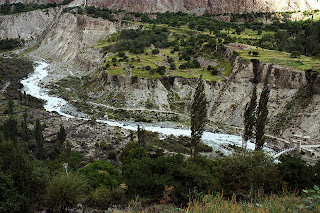Monday, January 28, 2013
Pakistan, UN seek to cut risk of glacial lake floods
Rina Saeed Khan in AlertNet): Abdul Jabbar was in his house in the Bindu Gol valley of Pakistan’s northern Chitral district when a glacial lake burst through the ridge holding it back high above. .. The boulders and rocks deposited by the massive flood also blocked the Chitral River at the base of the valley for 12 hours. When the river finally broke through, it swept away bridges and damaged settlements downstream.
As temperatures in Pakistan’s mountain regions rise and glacial lake outbursts become more common, people in Chitral - where every valley has at least one glacier - are becoming more anxious. “We need to study this glacier,” said Jabbar. “We believe the melting ice underneath the glacier might burst through again.”
The U.N. Development Programme (UNDP) and Pakistan’s Ministry of Climate Change have chosen Bindu Gol valley as one of two sites for a new project to reduce the risks of glacial lake flooding in northern Pakistan. This $7.6 million project is one of the first initiatives to be funded by the U.N.-backed Adaptation Fund, which finances programmes that help developing countries adapt to the negative effects of climate change.
The other project site is the picturesque valley of Bagrote in the northern mountain region of Gilgit-Baltistan, which is home to half a dozen glaciers. In Bagrote, glaciers and humans exist in close proximity, but the warming climate is bringing more dangerous conditions for the valley’s inhabitants.
Glacial Lake Outburst Floods (GLOFs) are happening regularly, caused by glaciers melting in the summer months. Floods occur when the natural dams - formed of ice or glacial sediment - containing the lakes are breached. They can occur quite suddenly, carry a lot of debris and cause considerable damage.
“Glacial flood events are more frequent now in Bagrote, destroying houses, livestock, graveyards and orchards. The community’s expectations from this project are high,” explained Shahid Ali, the head of a community-based organisation in the valley....
Bagrote Valley, in Gilgit-Baltistan, Pakistan, shot by Zensky, public domain
As temperatures in Pakistan’s mountain regions rise and glacial lake outbursts become more common, people in Chitral - where every valley has at least one glacier - are becoming more anxious. “We need to study this glacier,” said Jabbar. “We believe the melting ice underneath the glacier might burst through again.”
The U.N. Development Programme (UNDP) and Pakistan’s Ministry of Climate Change have chosen Bindu Gol valley as one of two sites for a new project to reduce the risks of glacial lake flooding in northern Pakistan. This $7.6 million project is one of the first initiatives to be funded by the U.N.-backed Adaptation Fund, which finances programmes that help developing countries adapt to the negative effects of climate change.
The other project site is the picturesque valley of Bagrote in the northern mountain region of Gilgit-Baltistan, which is home to half a dozen glaciers. In Bagrote, glaciers and humans exist in close proximity, but the warming climate is bringing more dangerous conditions for the valley’s inhabitants.
Glacial Lake Outburst Floods (GLOFs) are happening regularly, caused by glaciers melting in the summer months. Floods occur when the natural dams - formed of ice or glacial sediment - containing the lakes are breached. They can occur quite suddenly, carry a lot of debris and cause considerable damage.
“Glacial flood events are more frequent now in Bagrote, destroying houses, livestock, graveyards and orchards. The community’s expectations from this project are high,” explained Shahid Ali, the head of a community-based organisation in the valley....
Bagrote Valley, in Gilgit-Baltistan, Pakistan, shot by Zensky, public domain
Subscribe to:
Post Comments (Atom)




No comments:
Post a Comment